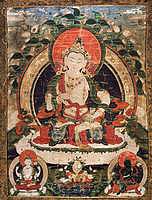
|
Tathagata Vajrasattva (painting no. 503)
|

View Larger Image |
||||||||||||||
|
The "ultimate being" and bodhisattva of purification, Vajrasattva is shown here in single form. In his left hand he cups wisdom's bell to his hip while in his right hand he raises aloft to his heart the vajra of compassion. Beneath this main figure is White Chenrezi, the patron bodhisattva of Tibet. Tara, Chenrezi's feminine reflex is on the other side. M. Mokotoff 2/98 [503] Vajrasattva (Tibetan: dor je sem pa. Eng.: Vajra Being), the buddha of purification. Vajrasattva, white in colour, has one face and two hands and holds with the right a gold vajra to the heart and with the left an upturned bell at the left hip. Richly adorned with gold and jewels in the form of a crown, earrings, bracelets, necklaces and the like, he is lavishly attired in fine silks of green and red colour. With the back swaying slightly to the left Vajrasattva sits in vajra posture on a moon disc seat above a white lotus blossom. His gentle face is framed by an orange and green areola and from the body rays of fine dark blue light radiate out to form a nimbus of gold adorned with wishing jewels and an outer rainbow glow. At the bottom left is Sadaksari Avalokiteshvara (the All Seeing Lord of Six Syllables), white, with one face and four hands seated in vajra posture on a lotus surrounded by circles of light. At the bottom right is Green Tara with one face and two hands holding two utpala flowers and seated in a relaxed posture on a lotus seat surrounded by circles of light. In this form Vajrasattva arises from the Yoga class of Tantras and is known as the ‘solitary universal ruler.’ Sometimes he is shown with the right leg stretched forward. Vajrasattva is an inner form of the buddha Vajradhara and represents all the peaceful buddha families. His practices and 100 syllable mantra are fundamental to all of Vajrayana Buddhism J.Watt 8-98
|
|||||||||||||||
Photographed Image Copyright © 1999 Shelley & Donald Rubin Foundation
|
|
| |
Next Image |